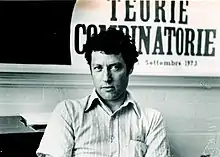Thomas H. Brylawski
Thomas Henry Brylawski (June 17, 1944 – July 18, 2007) was an American mathematician and professor at the University of North Carolina, Chapel Hill. He worked primarily in matroid theory.
Thomas H. Brylawski | |
|---|---|
 Tom Brylawski (from the Oberwolfach Photo Collection) | |
| Born | Thomas Henry Brylawski June 17, 1944 Washington, D.C., U.S. |
| Died | July 18, 2007 (aged 63) |
| Nationality | American |
| Other names | Tom Brylawski |
| Alma mater | |
| Known for | Matroid theory |
| Scientific career | |
| Fields | Mathematics |
| Institutions | University of North Carolina, Chapel Hill |
| Thesis | The Tutte–Grothendieck Ring (1970) |
| Doctoral advisors |
|
| Doctoral students | Jenny McNulty |
Education and career
Brylawski was born in 1944, and grew up in Washington, D.C.[1][2] He attended the Massachusetts Institute of Technology for his undergraduate degree, finishing with a Bachelor of Science in 1966. He then went on to Dartmouth College for his graduate work. He completed his PhD under the direction of Gian-Carlo Rota and Robert Norman in 1970.[3] After his PhD, he moved to the University of North Carolina, Chapel Hill, where he spent the rest of his career.[4][1]
Brylawski was an editor for the Proceedings of the American Mathematical Society from 1977 until 1989.[5] Brylawski wrote 40 mathematical publications,[6] and advised 6 PhD students.[3]
He died in 2007 of esophageal cancer at the Duke Hospice inpatient facility in Hillsborough, North Carolina.[2]
Work
Brylawski's early work used ideas and tools from category theory to understand the Tutte polynomial of a matroid. Indeed, this idea already appeared in his thesis, which made constructions in matroid theory similar to the Grothendieck group.[7][8] He developed similar ideas in two papers in the Transactions of the American Mathematical Society.[1][9][10] Another influential early paper of Brylawski's, published in the same journal, described the influence of a modular element in the lattice of flats on the characteristic polynomial of a matroid.[1][11]
Brylawski also contributed expository chapters to several matroid theory books that appeared in the Encyclopedia of Mathematics and its Applications series published by Cambridge University Press.[1] The Tutte polynomial chapter (written jointly with James Oxley) has around 500 citations.[12]
In addition to his work in matroid theory, Brylawski also had an interest in mathematics in art, particularly in the role of symmetry in art.[1] He gave lectures on mathematics in art on two occasions at the National Gallery of Art in Washington, D.C.[13][14]
Awards and honors
A memorial conference was held in honor of Brylawski in October 2008 at the University of North Carolina, Chapel Hill,[1] and a special issue of the European Journal of Combinatorics in 2011 was dedicated as a tribute to the work of Brylawski.[15]
References
- Gordon, Gary; McNulty, Jennifer (2011). "Thomas H. Brylawski (1944–2007)". European Journal of Combinatorics. 32 (6): 712–721. doi:10.1016/j.ejc.2011.02.009. ISSN 0195-6698. MR 2821546.
- "Obituaries for August 10, 2007". The Washington Post. Retrieved November 9, 2019.
- Thomas Henry Brylawski at the Mathematics Genealogy Project
- "Memorial page for Professor Thomas H. Brylawski" (PDF). University of North Carolina, Chapel Hill Department of Mathematics.
- "Past Editorial Board Members". Proceedings of the American Mathematical Society. Retrieved November 9, 2019.
- "Thomas H. Brylawski author profile". MathSciNet. American Mathematical Society.
- Brylawski, Thomas Henry (1970). The Tutte-Grothendieck Ring (PhD). Dartmouth College.
- Brylawski, T. H. (1972). "The Tutte-Grothendieck Ring". Algebra Universalis. 2 (1): 375–388. doi:10.1007/BF02945050. ISSN 0002-5240. MR 0330004. S2CID 121150927.
- Brylawski, Thomas (1971). "A Combinatorial Model for Series-Parallel Networks". Transactions of the American Mathematical Society. 154: 1. doi:10.1090/S0002-9947-1971-0288039-7. ISSN 0002-9947. MR 0288039.
- Brylawski, Thomas H. (1972). "A Decomposition for Combinatorial Geometries". Transactions of the American Mathematical Society. 171: 235–282. doi:10.1090/S0002-9947-1972-0309764-6. ISSN 0002-9947. MR 0309764.
- Brylawski, Tom (1975). "Modular Constructions for Combinatorial Geometries". Transactions of the American Mathematical Society. 203: 1–44. doi:10.1090/S0002-9947-1975-0357163-6. ISSN 0002-9947. MR 0357163.
- "The Tutte Polynomials and its Applications (citations)". Google Scholar. Retrieved March 15, 2021.
- "Calendar of Events for February 1973" (PDF). National Gallery of Art. Retrieved November 9, 2019.
- "Calendar of Events for April 1988" (PDF). National Gallery of Art. Retrieved November 9, 2019.
- Gordon, Gary; Oxley, James (2011). "Preface". European Journal of Combinatorics. 32 (6): 709–711. doi:10.1016/j.ejc.2011.02.006. ISSN 0195-6698. MR 2821545.